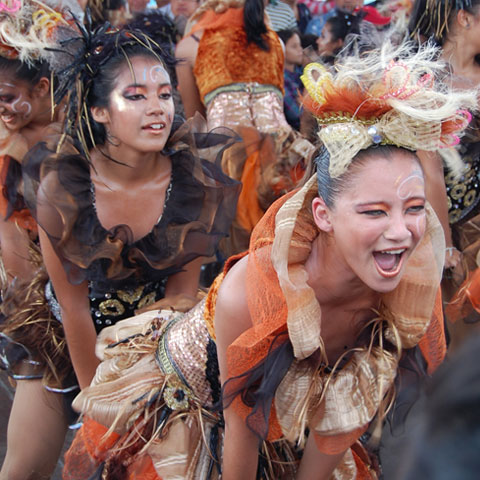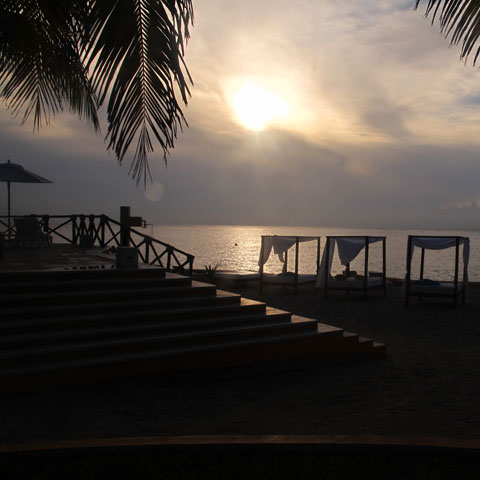Only one of the ancient seven wonders of the world are still standing today. With honor status it is ‘The Great Pyramid of Giza’ in Egypt, a vast kingdom of the ancient world. Four others were destroyed by earthquakes including ‘The Colossus of Rhodes’ (Κολοσσός της Ρόδου) that was built in 282 BC, but by 226 BC it had been destroyed completely by an earthquake. The Statue of Zeus at Olympia (Δίας μυθολογία) was one of two that were destroyed by fire in 426 AD. The Original Seven Wonders list was created in the 2nd century BCE, so an upgrade had been long overdue.
In 2000 a campaign to decide the ‘New Seven Wonders of the World’ commenced. More than 100 million people from around the globe voted on the internet or by text message, agreeing it was time for an updated List. In 2007 the final results were announced, the list of the seven (actually became eight) wonders of the world includes the astonishing:
- The Great Pyramid of Giza - Egypt (The only original Wonder left)
- The Great Wall of China - China
- Petra - Jordan
- Christ the Redeemer - Brazil
- Machu Picchu - Perú
- Chichen Itzá - México
- Colosseum - Italy
- Taj Mahal – India
Hard to believe that the impressive Acropolis in Athens, Greece didn’t even make the cut. The secrets hiding in all of these ancient archaeological sites have kept archaeologists, scholars, and inquisitive minds like mine guessing. Why? how? and in some cases who created these incredible marvels.
Chichén Itzá – México, 6th wonder of the world

Chichén Itzá is one such mystery, its name comes from a geological feature of sinkholes and caves in limestone formations called cenotes. Natural wells where the surface collapses exposing water underneath. This site is close to a huge cenote, called the Sacred Cenote. It supplied the city with fresh underground water. In 600 AD fresh drinking water was not only desired, but necessary for an empire to thrive.
Chi means “mouths” and chen means “wells” and Itzá is the name of the Maya tribe who settled there, who also influenced the name. The word Chichen Itza represents “At the mouth of the well of the Itza.”
The Spanish have their own spelling as Chichén Itzá. The Mayan spelling looks like this Chichʼen Itzaʼ, and El Castillo (“the Castle”) was the given name by the Spanish conquistadors.
Who really built it?
Well, this really has been my question for as long as I’ve known of this spectacular site. Like with Machu Picchu, it is clearly obvious it’s been built in different time zones, by different people. Vastly complex and enlightened advancement in architecture, and it’s sophisticated with ancient technology. It shows their exceptional intelligence in math, astrology, and geometry.
The Maya people of the Yucatán Peninsula have had the pleasure to live in this region since the Pre-Classic, or Formative, Period (1500 BCE–300 CE).
Some of the earliest structures constructed on this site are the Akabtzib (“House of the Dark Writing”), the Chichanchob (“Red House”), the Iglesia (“Church”), the Casa de las Monjas (“Nunnery”), and the observatory El Caracol (“The Snail”).
Famous Mayan site not entirely Mayan, then who?
In the 10th century foreign invaders descended on Mayan civilization, causing havoc and instability to the ancient nation. According to National Geographic and other sources, it was the Toltecs who invaded Chichén Itzá.
The Toltecs marked the rise of militarism in Mesoamerica. They also were noted as builders and craftsmen who dominated in Tula, Hidalgo, Mexico, during the Epiclassic and the early post-Classic period of Mesoamerican. They had roots in the Tolteca-Chichimeca people, who migrated from the deserts of the north-west to Culhuacan in the Valley of Mexico in the 9th century.
It’s said they are responsible for the most famous and recognizable structure, the Temple of Kukulkan. This Pyramid rises 24 meters (79 Feet) above the main center, there are 91 on each of the four sides, with 365 steps in total including the one at the top. These steps are equal to the number of days in each year.
Each side represented one season, this was used to figure out the best times for planting seeds and harvesting crops. This huge pyramid is actually an incredibly large working calendar.
The Serpent God descends on the pyramid twice a year

The Temple of Kukulkan has a magic design. Every year during spring (around March 20th and 21st) and autumn (around September 20th and 21st) equinoxes, the sun forms the shadow of a serpent on the pyramid. The shadow has a rising and falling in a wavelike pattern, resembling the body of a snake. As the sunsets it slowly moves down, before amalgamating with the serpent head at the bottom of the stairs.
On these dates, the light of the sun hits the earth directly on the equator, it’s the appearance of Quetzalcóatl/Kukulcán slithering down the steps. Thousands of tourists come to watch this phenomenon every year, and you could too. Almost-identical light-play can be seen the day before, without all the bustle of so many visitors.
Pyramids inside of Pyramids
Like a Russian doll, the Kukulkan Pyramid has two smaller pyramids inside this large structure. WHAT??? I know it sounds crazy but archaeological explorations have revealed the fascinating discovery of two earlier pyramids built inside of Kukulkan.
The two smaller pyramids are about 20 meters and 10 meters tall. This just opens the door to hundreds of more questions, all these ancient secrets locked away, crying out to be explored. Scientists compared the two smaller pyramids inside of Kukulkan to Russian nesting dolls. I’m still finding it hard to get my head around the fact there are pyramids inside of pyramids.
According to the Guardian, they think the smallest pyramid was probably built during the original Mayan reign before the Toltec invasion, but I’m having trouble believing this theory. It's best to do your own research and investigation right at the heart of this extraordinary archaeological site. Work out what makes logical sense to you.
Where did they go?

Chichen Itza was perfect to promote a political and commercial agenda by the Toltecs. It opened the passage for Itza merchants into central Mexico and other non-Maya areas, promoting the Itza economy.
More questions and mysteries, because sometime between the 12th and the 15th centuries this bustling ancient and superior civilization seems to have disappeared. Changing weather conditions, severe droughts, or maybe the rise of the Aztecs, or the arrival of Spanish could be the reason for the decline of such a glorious and colossal historic period.
What we are sure of, is that it was rediscovered by the world in 1841 by two great explorers John Lloyd Stephens and Frederick Catherwood. They had written about their travels though these ancient ruins in a book they published called ‘Incidents of Travel in Central America, Chiapas and Yucatan in 1841’. Even though many others had come across the pyramids earlier, there had been no official documentation.
By Santana Warner









